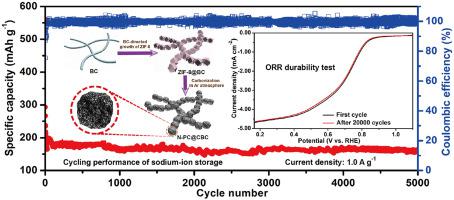Our official English website, www.x-mol.net, welcomes your
feedback! (Note: you will need to create a separate account there.)
N-doped porous carbon nanofibers fabricated by bacterial cellulose-directed templating growth of MOF crystals for efficient oxygen reduction reaction and sodium-ion storage
Carbon ( IF 10.5 ) Pub Date : 2020-10-01 , DOI: 10.1016/j.carbon.2020.06.052 Yang Huang , Kaiyuan Tang , Fanshu Yuan , Weiwei Zhang , Bengang Li , Farzad Seidi , Huining Xiao , Dongping Sun
Carbon ( IF 10.5 ) Pub Date : 2020-10-01 , DOI: 10.1016/j.carbon.2020.06.052 Yang Huang , Kaiyuan Tang , Fanshu Yuan , Weiwei Zhang , Bengang Li , Farzad Seidi , Huining Xiao , Dongping Sun

|
Abstract A nanofiber-directed templating strategy has been employed in this work to fabricate reticulated composites by decorating metal organic framework (MOF) onto a biomass scaffold of bacterial cellulose (BC). The abundant oxygen-containing groups on BC facilitate the highly dispersed nucleation of ZIF-8 (a typical MOF) and thus direct these nanocrystals assembly and growth along BC nanofibers homogeneously. The as-prepared ZIF-8@BC composites are converted into hierarchically porous carbon nanofibers with high intensity of N-dopants (N-PC@CBC) by a convenient carbonization process. In comparison with the bulk N-doping porous carbon (N-PC) by direct carbonization of pristine ZIF-8, N-PC@CBC exhibits more pronounced specific surface area and pore volume. As a result, N-PC@CBC shows outstanding oxygen reduction reaction catalytic performance approaching or even surpassing the commercial Pt/C catalyst. Additionally, the robust architecture of highly interweaved N-PC@CBC nanofibers as well as the sufficient N-dopants is also favorable for the enhancement of sodium-ion storage capability. After assembling the sodium-ion half-cells, the free-standing N-PC@CBC anodes display relatively high specific capacity, superior rate capability, and excellent cycling stability. The present work sheds light on a promising avenue to develop high-performance MOF-derived electrodes with cost-effective cellulose skeleton.
中文翻译:

通过细菌纤维素定向模板生长 MOF 晶体制备 N 掺杂的多孔碳纳米纤维,用于有效的氧还原反应和钠离子存储
摘要 在这项工作中采用了纳米纤维导向的模板策略,通过将金属有机框架 (MOF) 装饰到细菌纤维素 (BC) 的生物质支架上来制造网状复合材料。BC 上丰富的含氧基团促进了 ZIF-8(一种典型的 MOF)的高度分散成核,从而引导这些纳米晶体沿着 BC 纳米纤维均匀组装和生长。所制备的 ZIF-8@BC 复合材料通过方便的碳化过程转化为具有高强度 N 掺杂剂(N-PC@CBC)的分级多孔碳纳米纤维。与通过原始 ZIF-8 直接碳化的块状 N 掺杂多孔碳(N-PC)相比,N-PC@CBC 表现出更显着的比表面积和孔体积。因此,N-PC@CBC 表现出优异的氧还原反应催化性能,接近甚至超过商用 Pt/C 催化剂。此外,高度交织的 N-PC@CBC 纳米纤维的稳健结构以及充足的 N 掺杂剂也有利于提高钠离子存储能力。组装钠离子半电池后,独立式 N-PC@CBC 负极显示出相对较高的比容量、优异的倍率性能和优异的循环稳定性。目前的工作为开发具有成本效益的纤维素骨架的高性能 MOF 衍生电极开辟了一条有前途的途径。高度交织的 N-PC@CBC 纳米纤维的坚固结构以及足够的 N 掺杂剂也有利于提高钠离子存储能力。组装钠离子半电池后,独立式 N-PC@CBC 负极显示出相对较高的比容量、优异的倍率性能和优异的循环稳定性。目前的工作为开发具有成本效益的纤维素骨架的高性能 MOF 衍生电极开辟了一条有前途的途径。高度交织的 N-PC@CBC 纳米纤维的坚固结构以及足够的 N 掺杂剂也有利于提高钠离子存储能力。组装钠离子半电池后,独立式 N-PC@CBC 负极显示出相对较高的比容量、优异的倍率性能和优异的循环稳定性。目前的工作为开发具有成本效益的纤维素骨架的高性能 MOF 衍生电极开辟了一条有前途的途径。
更新日期:2020-10-01
中文翻译:

通过细菌纤维素定向模板生长 MOF 晶体制备 N 掺杂的多孔碳纳米纤维,用于有效的氧还原反应和钠离子存储
摘要 在这项工作中采用了纳米纤维导向的模板策略,通过将金属有机框架 (MOF) 装饰到细菌纤维素 (BC) 的生物质支架上来制造网状复合材料。BC 上丰富的含氧基团促进了 ZIF-8(一种典型的 MOF)的高度分散成核,从而引导这些纳米晶体沿着 BC 纳米纤维均匀组装和生长。所制备的 ZIF-8@BC 复合材料通过方便的碳化过程转化为具有高强度 N 掺杂剂(N-PC@CBC)的分级多孔碳纳米纤维。与通过原始 ZIF-8 直接碳化的块状 N 掺杂多孔碳(N-PC)相比,N-PC@CBC 表现出更显着的比表面积和孔体积。因此,N-PC@CBC 表现出优异的氧还原反应催化性能,接近甚至超过商用 Pt/C 催化剂。此外,高度交织的 N-PC@CBC 纳米纤维的稳健结构以及充足的 N 掺杂剂也有利于提高钠离子存储能力。组装钠离子半电池后,独立式 N-PC@CBC 负极显示出相对较高的比容量、优异的倍率性能和优异的循环稳定性。目前的工作为开发具有成本效益的纤维素骨架的高性能 MOF 衍生电极开辟了一条有前途的途径。高度交织的 N-PC@CBC 纳米纤维的坚固结构以及足够的 N 掺杂剂也有利于提高钠离子存储能力。组装钠离子半电池后,独立式 N-PC@CBC 负极显示出相对较高的比容量、优异的倍率性能和优异的循环稳定性。目前的工作为开发具有成本效益的纤维素骨架的高性能 MOF 衍生电极开辟了一条有前途的途径。高度交织的 N-PC@CBC 纳米纤维的坚固结构以及足够的 N 掺杂剂也有利于提高钠离子存储能力。组装钠离子半电池后,独立式 N-PC@CBC 负极显示出相对较高的比容量、优异的倍率性能和优异的循环稳定性。目前的工作为开发具有成本效益的纤维素骨架的高性能 MOF 衍生电极开辟了一条有前途的途径。











































 京公网安备 11010802027423号
京公网安备 11010802027423号